Interventions to Reduce Intra-Operative and Post-Operative Pain Associated with Routine Dental Procedures in Children: A Systematic Review and Meta-Analysis
Abstract
1. Introduction
2. Material and Methods
2.1. Inclusion Criteria
2.2. Exclusion Criteria
2.3. Search Strategy
2.4. Data Extraction
2.5. Quality Assessment
2.6. Data Analysis
2.7. Strength/Certainty of Evidence
3. Results
3.1. Study Selection
3.2. Study Characteristics
3.3. Quality Assessment for Risk of Bias
3.4. Meta-Analyses
3.4.1. Local Anaesthesia
Computer-Driven LA Versus Conventional LA
Intraosseous/Intra-Ligamentary LA Versus Conventional LA
LA Agent (Articaine Versus Lidocaine)
Topical Anaesthesia
3.4.2. Intra-Operative Pain Outcome
3.4.3. Mechanoreceptor and Thermal Receptor Stimulation
3.4.4. Behavioural Interventions
3.4.5. Post-Operative Pain Outcome
3.4.6. Anxiety Outcome
3.5. Certainty of Evidence and GRADE Recommendations
4. Discussion
4.1. Summary of Main Findings
4.2. Strengths and Limitations
4.3. Comparison with Previous Literature and Future Research
5. Conclusions
Supplementary Materials
Author Contributions
Funding
Acknowledgments
Conflicts of Interest
References
- Kassebaum, N.J.; Smith, A.G.; Bernabé, E.; Fleming, T.D.; Reynolds, A.E.; Vos, T.; Murray, C.J.L.; Marcenes, W.; GBD 2015 Oral Health Collaborators. Global, regional, and national prevalence, incidence, and disability-adjusted life years for oral conditions for 195 countries, 1990–2015: A systematic analysis for the global burden of diseases, injuries, and risk factors. J. Dent. Res. 2017, 96, 380–387. [Google Scholar] [CrossRef]
- Public Health England. National Dental Epidemiology Programme for England: Oral Health Survey of 5-Year-Olds 2019; Public Heath England: London, UK, 2020.
- Freeman, R.; Maguire, A.; Ryan, V.; Wilson, N.; Innes, N.P.; Clarkson, J.E.; McColl, E.; Marshman, Z.; Robertson, M.; Abouhajar, A.; et al. The FiCTION trial: Child oral health-related quality of life and dental anxiety across three treatment strategies for managing caries in young children. Community Dent. Oral Epidemiol. 2020, 48, 328–337. [Google Scholar] [CrossRef]
- Threlfall, A.G.; Pilkington, L.; Milsom, K.M.; Blinkhorn, A.S.; Tickle, M. General dental practitioners’ views on the use of stainless steel crowns to restore primary molars. Br. Dent. J. 2005, 199, 453–455. [Google Scholar] [CrossRef]
- Adewale, L. Anaesthesia for paediatric dentistry. BJA Educ. 2012, 12, 288–294. [Google Scholar] [CrossRef]
- Ghanei, M.; Arnrup, K.; Robertson, A. Procedural pain in routine dental care for children: A part of the Swedish BITA study. Eur. Arch. Paediatr. Dent. 2018, 19, 365–372. [Google Scholar] [CrossRef]
- Alzubaidi, M.A.; Drummond, B.K.; Wu, J.; Jones, A.; Tahmassebi, J.F.; Aggarwal, V.R. Predictors of intra-operative and post-operative pain associated with routine dental procedures in children: A systematic review and meta-analysis. Dent. J. 2024, 12, 4. [Google Scholar] [CrossRef]
- Nakai, Y.; Hirakawa, T.; Milgrom, P.; Coolidge, T.; Heima, M.; Mori, Y.; Ishihara, C.; Yakushiji, N.; Yoshida, T.; Shimono, T. The children’s fear survey schedule–dental subscale in Japan. Community Dent. Oral Epidemiol. 2005, 33, 196–204. [Google Scholar] [CrossRef]
- Krekmanova, L.; Bergius, M.; Robertson, A.; Krekmanova, L.; Bergius, M.; Robertson, A.; Sabel, N.; Hafström, C.; Klingberg, G.; Berggren, U. Everyday-and dental-pain experiences in healthy Swedish 8–19 year olds: An epidemiological study. Int. J. Paediatr. Dent. 2009, 19, 438–447. [Google Scholar] [CrossRef]
- Naoumova, J.; Kjellberg, H.; Kurol, J.; Mohlin, B. Pain, discomfort, and use of analgesics following the extraction of primary canines in children with palatally displaced canines. Int. J. Paediatr. Dent. 2012, 22, 17–26. [Google Scholar] [CrossRef]
- Krekmanova, L. Pain in Pediatric Dentistry. Ph.D. Thesis, University of Gothenburg, Gothenburg, Sweden, 2017. [Google Scholar]
- Knapp, R.; Marshman, Z.; Rodd, H. Treatment of dental caries under general anaesthetic in children. BDJ Team 2017, 4, 7–10. [Google Scholar] [CrossRef]
- Liberati, A.; Altman, D.G.; Tetzlaff, J.; Mulrow, C.; Gøtzsche, P.C.; Ioannidis, J.P.; Clarke, M.; Devereaux, P.J.; Kleijnen, J.; Moher, D. The PRISMA statement for reporting systematic reviews and meta-analyses of studies that evaluate health care interventions: Explanation and elaboration. Ann. Intern. Med. 2009, 151, 65–94. [Google Scholar] [CrossRef] [PubMed]
- Moher, D.; Liberati, A.; Tetzlaff, J.; Altman, D.G.; PRISMA Group*, T. Preferred reporting items for systematic reviews and meta-analyses: The PRISMA statement. Ann. Intern. Med. 2009, 151, 264–269. [Google Scholar] [CrossRef] [PubMed]
- The EndNote; Version 9; Clarivate: Philadelphia, PA, USA, 2013.
- Covidence Systematic Review Software. Veritas Health Innovation. 2014. Available online: https://www.covidence.org (accessed on 26 June 2020).
- Higgins, J.P.; Green, S. Cochrane Handbook for Systematic Reviews of Interventions; John Wiley & Sons: Chichester, UK, 2011; Volume 4. [Google Scholar]
- Microsoft Corporation. Microsoft Excel; Microsoft Corporation: Redmond, WA, USA, 2018. [Google Scholar]
- Stata 16 Statistical Software; StataCorp: College Station, TX, USA, 2019.
- Mumtaz, M.O.; Ajay, R.H.; Bhat, S.S.; Sargod, S.; Riyas, A.K.; Suvarna, R.M.; Shabbir, A.; Hegde, N. Comparison of the Local Anaesthetic Effect of 4% Articaine and 2% Lidocaine Administered Using Inferior Alveolar Nerve Block Technique in Primary Mandibular Molar Extractions. J. Evol. Med. Dent. Sci. 2021, 10, 13–19. [Google Scholar]
- Law, S.L.S.; Southard, K.A.; Law, A.S.; Logan, H.L.; Jakobsen, J.R. An evaluation of preoperative ibuprofen for treatment of pain associated with orthodontic separator placement. Am. J. Orthod. Dentofac. Orthop. 2000, 118, 629–635. [Google Scholar]
- Bernhardt, M.K.; Southard, K.A.; Batterson, K.D.; Logan, H.L.; Baker, K.A.; Jakobsen, J.R. The effect of preemptive and/or postoperative ibuprofen therapy for orthodontic pain. Am. J. Orthod. Dentofac. Orthop. 2001, 120, 20–27. [Google Scholar] [CrossRef] [PubMed]
- Versloot, J.; Veerkamp, J.S.; Hoogstraten, J. Computerized anesthesia delivery system vs. traditional syringe: Comparing pain and pain-related behavior in children. Eur. J. Oral Sci. 2005, 113, 488–493. [Google Scholar] [CrossRef] [PubMed]
- Versloot, J.; Veerkamp, J.S.J.; Hoogstraten, J. Pain behaviour and distress in children during two sequential dental visits: Comparing a computerised anaesthesia delivery system and a traditional syringe. Br. Dent. J. 2008, 205, 2–6. [Google Scholar] [CrossRef] [PubMed]
- Huet, A.; Lucas-Polomeni, M.M.; Robert, J.C.; Sixou, J.L.; Wodey, E. Hypnosis and dental anesthesia in children: A prospective controlled study. Int. J. Clin. Exp. Hypn. 2011, 59, 424–440. [Google Scholar] [CrossRef] [PubMed]
- Kamath, P.S. A novel distraction technique for pain management during local anesthesia administration in pediatric patients. J. Clin. Pediatr. Dent. 2013, 38, 45–47. [Google Scholar] [CrossRef]
- Alamoudi, N.M.; Baghlaf, K.K.; Elashiry, E.A.; Farsi, N.M.; El Derwi, D.A.; Bayoumi, A.M. The effectiveness of computerized anesthesia in primary mandibular molar pulpotomy: A randomized controlled trial. Quintessence Int. 2015, 47, 1–8. [Google Scholar]
- Baghlaf, K.; Alamoudi, N.; Elashiry, E.; Farsi, N.; El Derwi, D.A.; Abdullah, A.M. The pain-related behavior and pain perception associated with computerized anesthesia in pulpotomies of mandibular primary molars: A randomized controlled trial. Quintessence Int. 2015, 46, 799–806. [Google Scholar] [PubMed]
- Mittal, M.; Kumar, A.; Srivastava, D.; Sharma, P.; Sharma, S. Pain perception: Computerized versus traditional local anesthesia in pediatric patients. J. Clin. Pediatr. Dent. 2015, 39, 470–474. [Google Scholar] [CrossRef] [PubMed]
- Abdelmoniem, S.A.; Mahmoud, S.A. Comparative evaluation of passive, active, and passive-active distraction techniques on pain perception during local anesthesia administration in children. J. Adv. Res. 2016, 7, 551–556. [Google Scholar] [CrossRef] [PubMed]
- Agarwal, N.; Dhawan, J.; Kumar, D.; Anand, A.; Tangri, K. Effectiveness of two topical anaesthetic agents used along with audio visual aids in paediatric dental patients. J. Clin. Diagn. Res. 2017, 11, 80–83. [Google Scholar] [CrossRef] [PubMed]
- Ramirez-Carrasco, A.; Butron-Tellez Giron, C.; Sanchez-Armass, O.; Pierdant-Pérez, M. Effectiveness of hypnosis in combination with conventional techniques of behavior management in anxiety/pain reduction during dental anesthetic infiltration. Pain Res. Manag. 2017, 2017, 1–5. [Google Scholar] [CrossRef] [PubMed]
- Al-Halabi, M.N.; Bshara, N.; AlNerabieah, Z. Effectiveness of audio visual distraction using virtual reality eyeglasses versus tablet device in child behavioral management during inferior alveolar nerve block. Anaesth. Pain Intensive Care 2018, 22, 55–61. [Google Scholar]
- Arcari, S.; Moscati, M. Nitrous oxide analgesic effect on children receiving restorative treatment on primary molars Introduction. Eur. J. Paediatr. Dent. 2018, 19, 205–212. [Google Scholar] [PubMed]
- Tung, J.; Carillo, C.; Udin, R.; Wilson, M.; Tanbonliong, T. Clinical performance of the DentalVibe® injection system on pain perception during local anesthesia in children. J. Dent. Child. 2018, 85, 51–57. [Google Scholar]
- Sridhar, S.; Suprabha, B.S.; Shenoy, R.; Shwetha, K.T.; Rao, A. Effect of a relaxation training exercise on behaviour, anxiety, and pain during buccal infiltration anaesthesia in children: Randomized clinical trial. Int. J. Paediatr. Dent. 2019, 29, 596–602. [Google Scholar] [CrossRef]
- Massignan, C.; Silveira Santos, P.; Cardoso, M.; Bolan, M. Efficacy and adverse events of 4% articaine compared with 2% lidocaine on primary molar extraction: A randomised controlled trial. J. Oral Rehabil. 2020, 47, 1031–1040. [Google Scholar] [CrossRef]
- Obadiah, I.; Subramanian, E.M.G. Effect of a Relaxation Training Exercise on Behaviour, Anxiety and Pain During Administration of Intra-Oral Local Anaesthesia in Children of Age 6 to 12 years: Randomized Controlled Trial. J. Res. Med. Dent. Sci. 2020, 8, 364–370. [Google Scholar]
- Santos, P.S.; Massignan, C.; de Oliveira, E.V.; Miranda Santana, C.; Bolan, M.; Cardoso, M. Does the pre-emptive administration of paracetamol or ibuprofen reduce trans-and post-operative pain in primary molar extraction? A randomized placebo-controlled clinical trial. Int. J. Paediatr. Dent. 2020, 30, 782–790. [Google Scholar] [CrossRef] [PubMed]
- Smolarek, P.D.C.; da Silva, L.S.; Martins, P.R.D.; Hartman, K.D.C.; Bortoluzzi, M.C.; Chibinski, A.C.R. Evaluation of pain, disruptive behaviour and anxiety in children aging 5–8 years old undergoing different modalities of local anaesthetic injection for dental treatment: A randomised clinical trial. Acta Odontol. Scand. 2020, 78, 445–453. [Google Scholar] [CrossRef] [PubMed]
- Alshami, A.A.; Alhamed, S.A.; Almahri, J.R.; AlSaggabi, F.A.; Alshahrani, A.S. Effect of pre-operative administration of ibuprofen in children undergoing extraction for reducing post-operative pain: A double-blind randomised controlled clinical trial. Br. Dent. J. 2021, 1–5. [Google Scholar] [CrossRef] [PubMed]
- Raslan, N.; Zouzou, T. Comparison of preemptive ibuprofen, acetaminophen, and placebo administration in reducing peri-and postoperative pain in primary tooth extraction: A randomized clinical trial. Clin. Exp. Dent. Res. 2021, 7, 1045–1052. [Google Scholar] [CrossRef] [PubMed]
- Vidigal, E.A.; Abanto, J.; Leyda, A.M.; Berti, G.O.; Aillón, I.E.V.; Corrêa, M.S.N.P.; Bönecker, M. Comparison of two behavior management techniques used during mandibular block anesthesia among preschool children: A randomized clinical trial. European Arch. Paediatr. Dent. 2021, 22, 773–781. [Google Scholar] [CrossRef] [PubMed]
- Helmy, R.H.; Zeitoun, S.I.; El-Habashy, L.M. Computer-controlled Intraligamentary local anaesthesia in extraction of mandibular primary molars: Randomised controlled clinical trial. BMC Oral Health 2022, 22, 1–10. [Google Scholar] [CrossRef] [PubMed]
- Baghdadi, Z.D. Evaluation of electronic dental anesthesia in children. Oral Surg. Oral Med. Oral Pathol. Oral Radiol. Endodontology 1999, 88, 418–423. [Google Scholar] [CrossRef] [PubMed]
- Primosch, R.E.; Rolland-Asensi, G. Comparison of topical EMLA 5% oral adhesive to benzocaine 20% on the pain experienced during palatal anesthetic infiltration in children. Pediatr. Dent. 2001, 23, 11–14. [Google Scholar]
- Oztas, N.; Ulusu, T.; Bodur, H.; Dogan, C. The wand in pulp therapy: An alternative to inferior alveolar nerve block. Quintessence Int. 2005, 36, 559–564. [Google Scholar]
- Ram, D.; Amir, E. Comparison of articaine 4% and lidocaine 2% in paediatric dental patients. Int. J. Paediatr. Dent. 2006, 16, 252–256. [Google Scholar] [CrossRef] [PubMed]
- Ghaderi, F.; Banakar, S.; Rostami, S. Effect of pre-cooling injection site on pain perception in pediatric dentistry: “A randomized clinical trial”. Dent. Res. J. 2013, 10, 790–794. [Google Scholar]
- Atabek, D.; Cinar, C.; Sillelioglu, H.; Bani, M.; Kip, G. Comparison of topical 10 percent lidocaine and a local anesthetic system in pediatric dental patients. J. Dent. Child. 2015, 82, 91–96. [Google Scholar]
- Asvanund, Y.; Mitrakul, K.; Juhong, R.O.; Arunakul, M. Effect of audiovisual eyeglasses during local anesthesia injections in 5-to 8-year-old children. Quintessence Int. 2015, 46, 513–521. [Google Scholar] [PubMed]
- Attar, R.H.; Baghdadi, Z.D. Comparative efficacy of active and passive distraction during restorative treatment in children using an iPad versus audiovisual eyeglasses: A randomised controlled trial. Eur. Arch. Paediatr. Dent. 2015, 16, 1–8. [Google Scholar] [CrossRef] [PubMed]
- Shilpapriya, M.; Jayanthi, M.; Reddy, V.N.; Sakthivel, R.; Selvaraju, G.; Vijayakumar, P. Effectiveness of new vibration delivery system on pain associated with injection of local anesthesia in children. J. Indian Soc. Pedod. Prev. Dent. 2015, 33, 173–176. [Google Scholar] [PubMed]
- Dak-Albab, R.; Al-Monaqel, M.B.; Koshha, R.; Shakhashero, H.; Soudan, R. A comparison between the effectiveness of vibration with Dentalvibe and benzocaine gel in relieving pain associated with mandibular injection: A randomized clinical trial. Anaesth. Pain Intensive Care 2016, 20, 43–49. [Google Scholar]
- Alinejhad, D.; Bahrololoomi, Z.; Navabazam, A.; Asayesh, M.A. Comparison of Visual Analog Scale Scores in Pain Assessment during Pulpotomy using Different Injection Materials in Children Aged 6 to 8 and 8 to 10 Years. J. Contemp. Dent. Pract. 2018, 19, 313–317. [Google Scholar] [CrossRef] [PubMed]
- Garrocho-Rangel, A.; Ibarra-Gutierrez, E.; Rosales-Berber, M.; Esquivel-Hernández, R.; Esparza-Villalpando, V.; Pozos-Guillén, A. A video eyeglasses/earphones system as distracting method during dental treatment in children: A crossover randomised and controlled clinical trial. Eur. J. Paediatr. Dent. 2018, 19, 74–79. [Google Scholar]
- Wambier, L.M.; Demogalski, J.T.; Puja, D.B.; Chibinski, A.C.; Wambier, D.S.; Farago, P.V.; Loguercio, A.D.; Reis, A. Efficacy of a new light- cured anesthetic gel for clamp placement before rubber dam isolation in children: A triple-blinded randomized controlled clinical trial. Am. J. Dent. 2018, 31, 126–130. [Google Scholar]
- Alanazi, K.J.; Pani, S.; AlGhanim, N. Efficacy of external cold and a vibrating device in reducing discomfort of dental injections in children: A split mouth randomised crossover study. Eur. Arch. Paediatr. Dent. 2019, 20, 79–84. [Google Scholar] [CrossRef] [PubMed]
- Gumus, H.; Aydinbelge, M. Evaluation of effect of warm local anesthetics on pain perception during dental injections in children: A split- mouth randomized clinical trial. Clin. Oral Investig. 2020, 24, 2315–2319. [Google Scholar] [CrossRef] [PubMed]
- Yildirim, S.; Tokuc, M.; Aydin, M.N. The effect of pre-anesthesia with a needle-free system versus topical anesthesia on injection pain of the inferior alveolar nerve block: A randomized clinical trial. Clin. Oral Investig. 2020, 24, 4355–4361. [Google Scholar] [CrossRef] [PubMed]
- AmruthaVarshini, I.; Vinay, C.; Uloopi, K.S.; RojaRamya, K.S.; Chandrasekhar, R.; Penmatsa, C. Effectiveness of Pre-cooling the Injection Site, Laser Biostimulation, and Topical Local Anesthetic Gel in Reduction of Local Anesthesia Injection Pain in Children. Int. J. Clin. Pediatr. Dent. 2021, 14, 81–83. [Google Scholar] [CrossRef] [PubMed]
- Daneshvar, S.H.; Dorani, D.; Daneshvar, M.M. Comparison of anaesthetic efficacy of 4% articaine buccal infiltration versus 2% lidocaine inferior alveolar nerve block for pulpotomy in mandibular primary second molars. J. Indian Soc. Pedod. Prev. Dent. 2021, 39, 299–302. [Google Scholar] [CrossRef] [PubMed]
- Jain, N.; Juneja, P.; Masih, U.; Bhushan, A.B.; Bhaduaria, U.S.; Badjatya, K. Efficacy of external cold and a vibrating device in reducing pain and anxiety during local anaesthesia. J. Fam. Med. Prim. Care 2021, 10, 4017–4022. [Google Scholar] [CrossRef] [PubMed]
- Smail-Faugeron, V.; Muller-Bolla, M.; Sixou, J.L.; Courson, F. Evaluation of intraosseous computerized injection system (QuickSleeperTM) vs conventional infiltration anaesthesia in paediatric oral health care: A multicentre, single-blind, combined split-mouth and parallel-arm randomized controlled trial. Int. J. Paediatr. Dent. 2019, 29, 573–584. [Google Scholar] [CrossRef] [PubMed]
- Ashley, P.F.; Parekh, S.; Moles, D.R.; Anand, P.; MacDonald, L.C. Preoperative analgesics for additional pain relief in children and adolescents having dental treatment. Cochrane Database Syst. Rev. 2016, CD008392. [Google Scholar] [CrossRef] [PubMed]
- Smolarek, P.D.C.; Wambier, L.M.; Siqueira Silva, L.; Chibinski, A.C.R. Does computerized anaesthesia reduce pain during local anaesthesia in paediatric patients for dental treatment? A systematic review and meta-analysis. Int. J. Paediatr. Dent. 2020, 30, 118–135. [Google Scholar] [CrossRef]
- Melzack, R.; Wall, P.D. Pain Mechanisms: A New Theory: A gate control system modulates sensory input from the skin before it evokes pain perception and response. Science 1965, 150, 971–979. [Google Scholar] [CrossRef]
- Monteiro, J.; Tanday, A.; Ashley, P.F.; Parekh, S.; Alamri, H. Interventions for increasing acceptance of local anaesthetic in children and adolescents having dental treatment. Cochrane Database Syst. Rev. 2020, 2020, CD011024. [Google Scholar] [CrossRef] [PubMed]
- Goettems, M.L.; Zborowski, E.J.; dos Santos Costa, F.; Costa, V.P.P.; Torriani, D.D. Nonpharmacologic intervention on the prevention of pain and anxiety during pediatric dental care: A systematic review. Acad. Pediatr. 2017, 17, 110–119. [Google Scholar] [CrossRef] [PubMed]
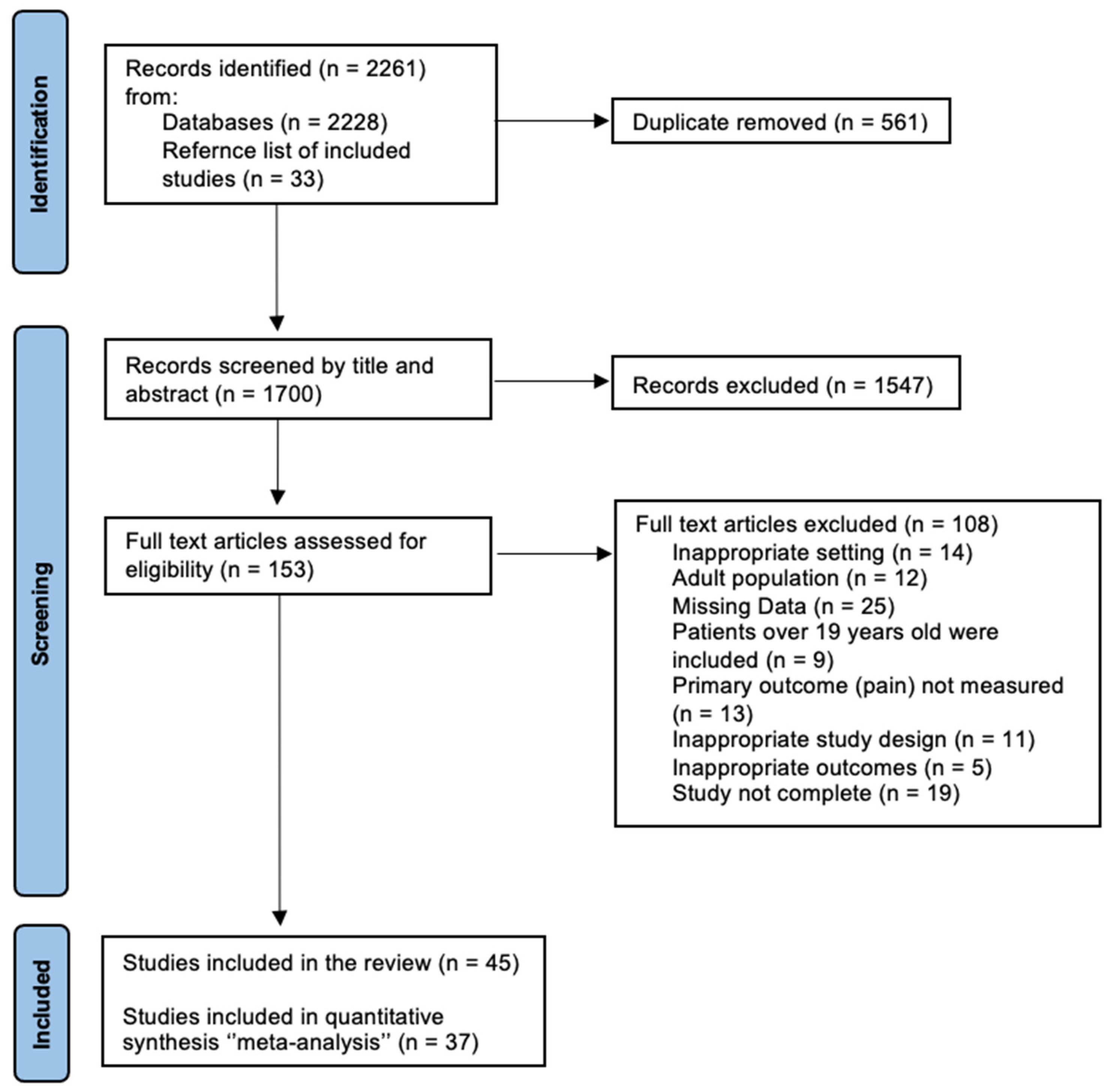
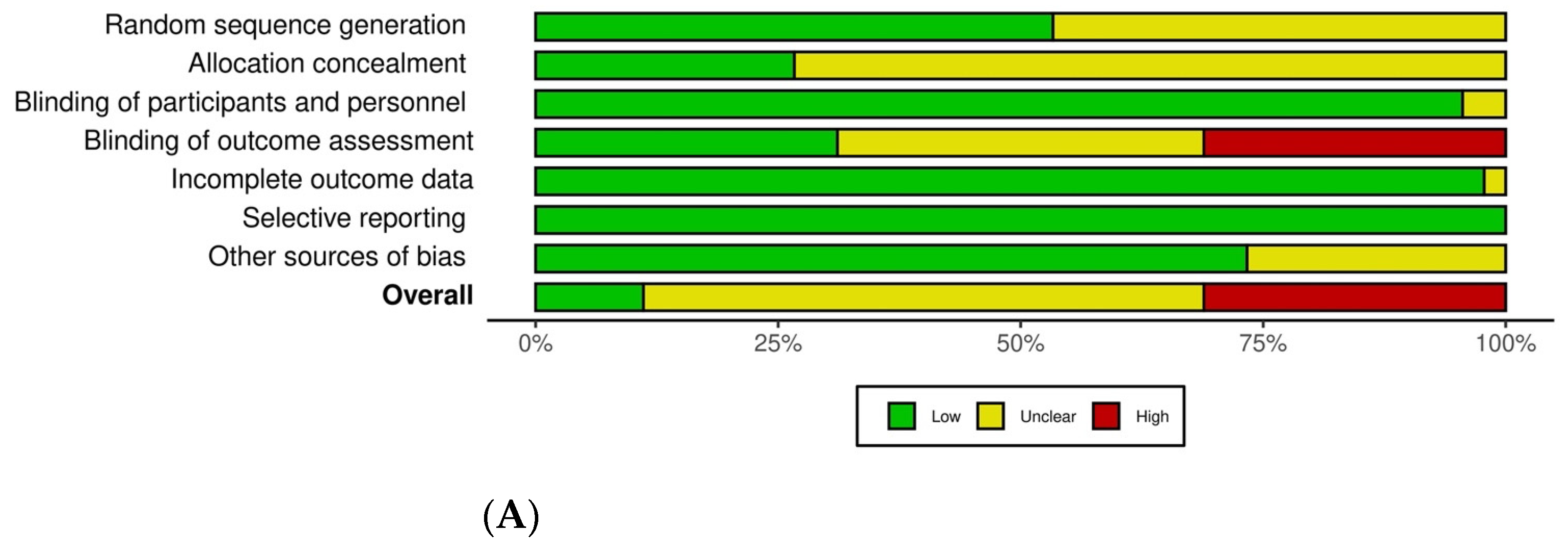
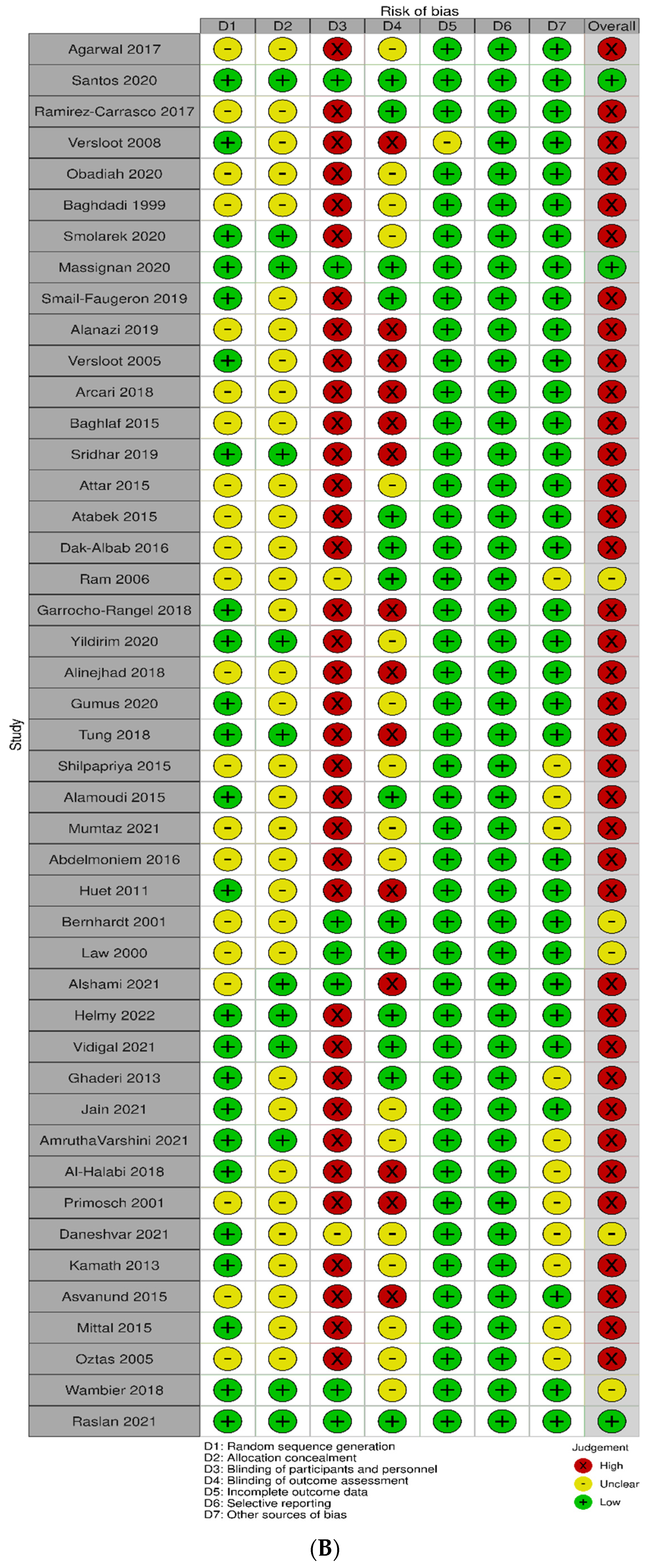
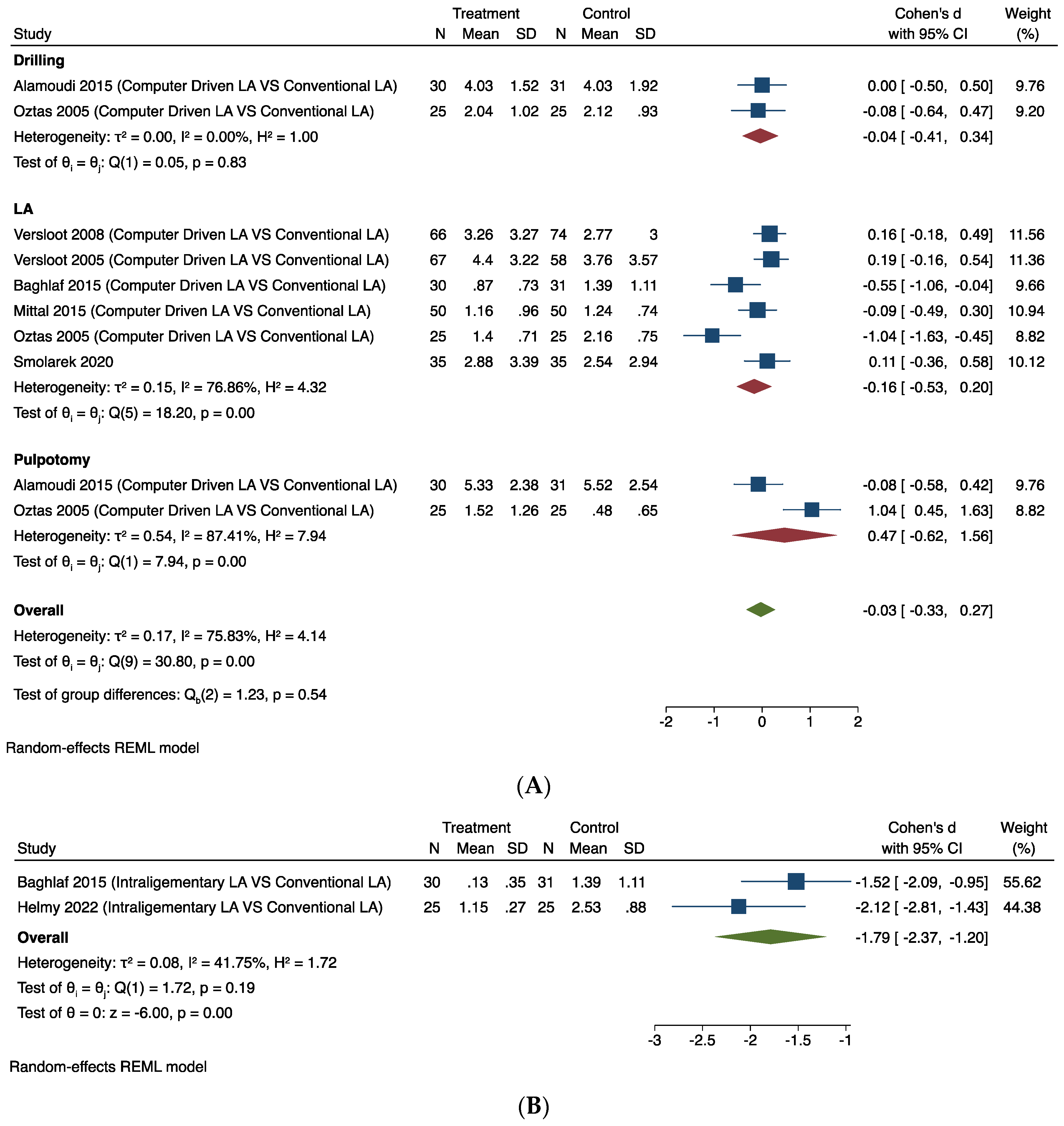
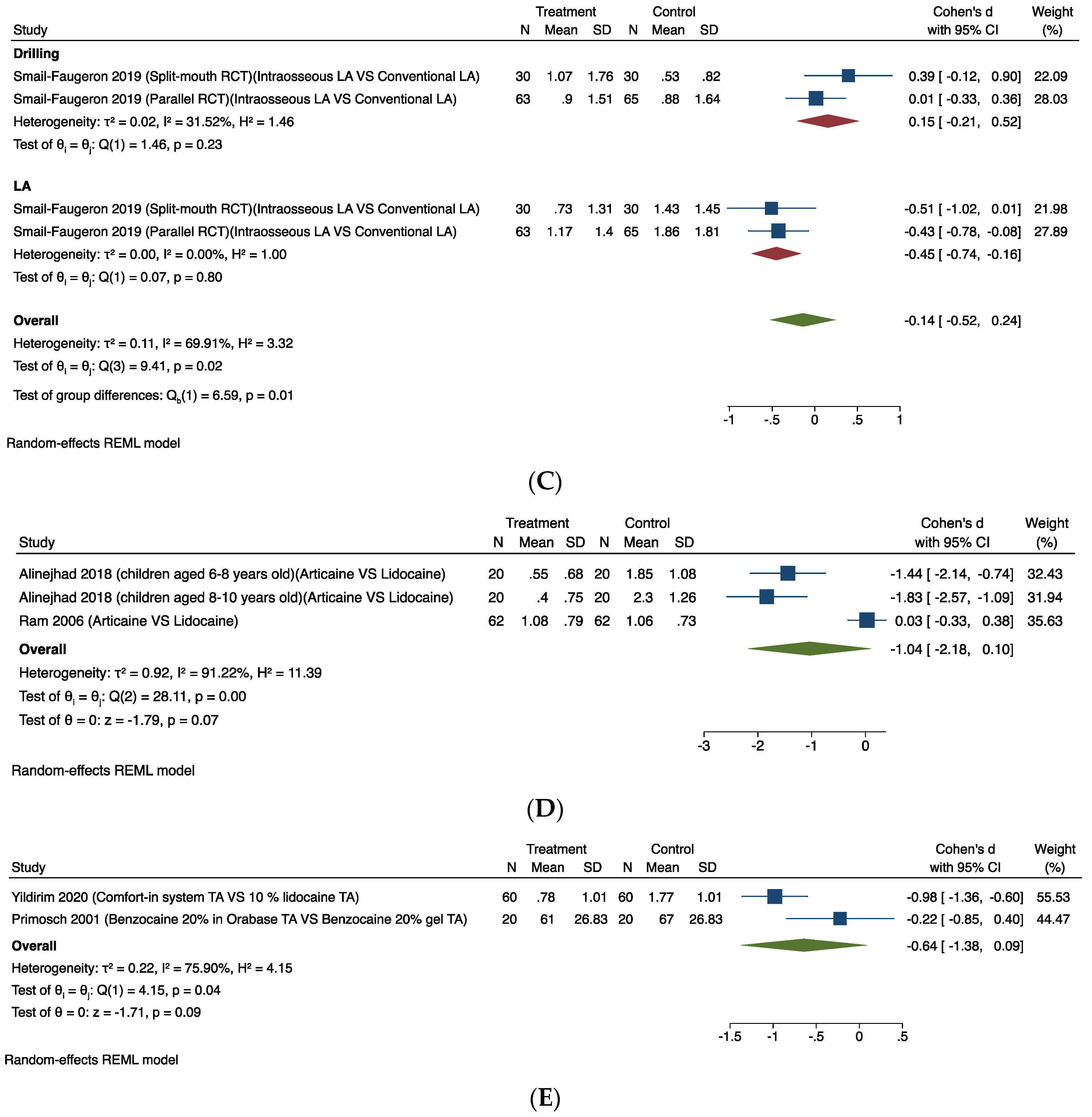
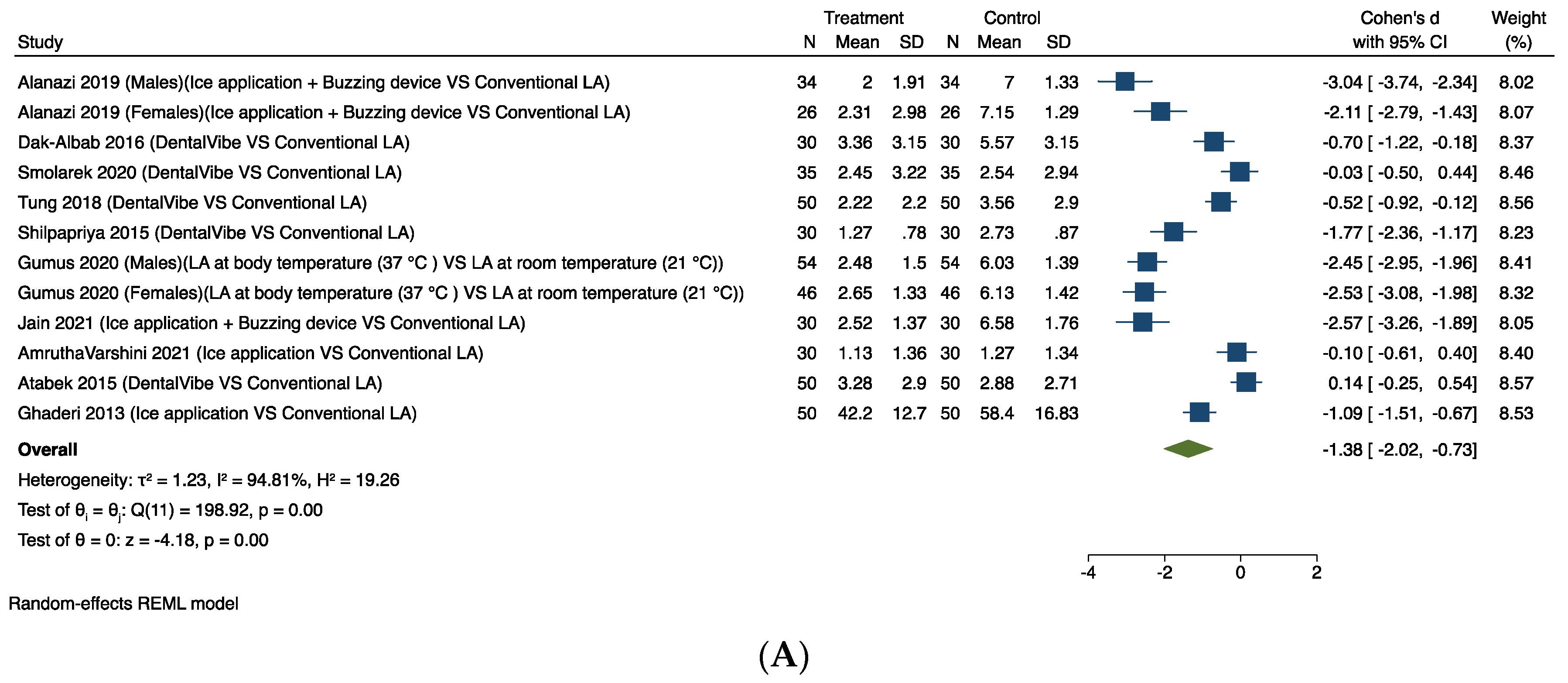

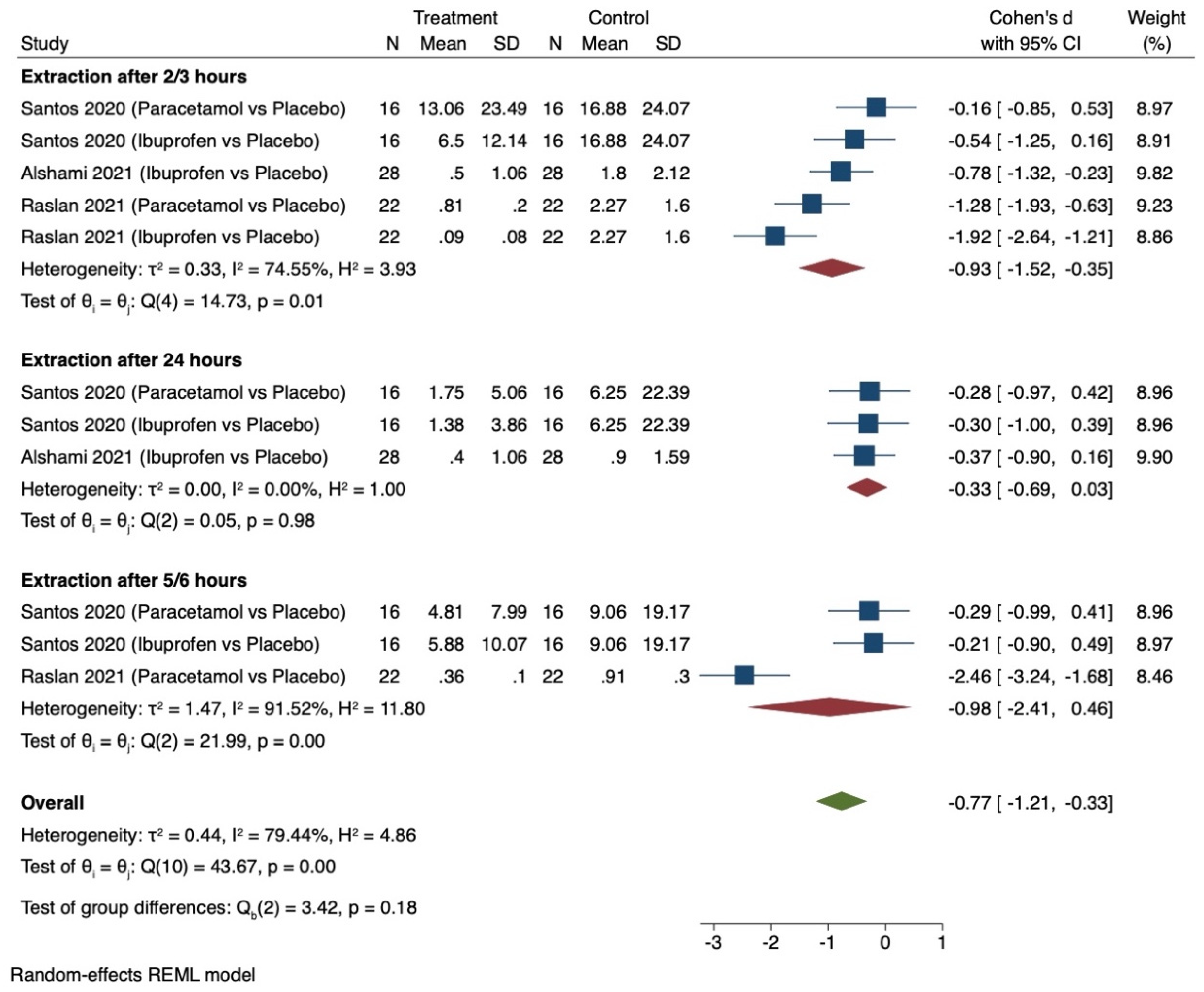
| Intervention | Effect Size and Conclusions | GRADE Recommendation |
|---|---|---|
| Mechanoreceptor and thermal receptor stimulation (intra-operative pain outcome) | SMD 1.38, SD lower (2.02 lower to 0.73 lower) Moderate level of evidence | IB, strong recommendation based on the moderate level of evidence |
| Behavioural interventions (intra-operative pain outcome) | SMD 0.5, SD lower (0.83 lower to 0.18 lower) Moderate level of evidence | IB, strong recommendation based on the moderate level of evidence |
| Pharmacological interventions: oral analgesics (post-operative pain outcome) | SMD 0.77, SD lower (1.21 lower to 0.33 lower) Moderate level of evidence | IB, strong recommendation based on the moderate level of evidence |
Disclaimer/Publisher’s Note: The statements, opinions and data contained in all publications are solely those of the individual author(s) and contributor(s) and not of MDPI and/or the editor(s). MDPI and/or the editor(s) disclaim responsibility for any injury to people or property resulting from any ideas, methods, instructions or products referred to in the content. |
© 2024 by the authors. Licensee MDPI, Basel, Switzerland. This article is an open access article distributed under the terms and conditions of the Creative Commons Attribution (CC BY) license (https://creativecommons.org/licenses/by/4.0/).
Share and Cite
Alzubaidi, M.A.; Drummond, B.K.; Wu, J.; Jones, A.; Aggarwal, V.R. Interventions to Reduce Intra-Operative and Post-Operative Pain Associated with Routine Dental Procedures in Children: A Systematic Review and Meta-Analysis. Dent. J. 2024, 12, 163. https://doi.org/10.3390/dj12060163
Alzubaidi MA, Drummond BK, Wu J, Jones A, Aggarwal VR. Interventions to Reduce Intra-Operative and Post-Operative Pain Associated with Routine Dental Procedures in Children: A Systematic Review and Meta-Analysis. Dentistry Journal. 2024; 12(6):163. https://doi.org/10.3390/dj12060163
Chicago/Turabian StyleAlzubaidi, Mohammed A., Bernadette K. Drummond, Jianhua Wu, Adam Jones, and Vishal R. Aggarwal. 2024. "Interventions to Reduce Intra-Operative and Post-Operative Pain Associated with Routine Dental Procedures in Children: A Systematic Review and Meta-Analysis" Dentistry Journal 12, no. 6: 163. https://doi.org/10.3390/dj12060163
APA StyleAlzubaidi, M. A., Drummond, B. K., Wu, J., Jones, A., & Aggarwal, V. R. (2024). Interventions to Reduce Intra-Operative and Post-Operative Pain Associated with Routine Dental Procedures in Children: A Systematic Review and Meta-Analysis. Dentistry Journal, 12(6), 163. https://doi.org/10.3390/dj12060163








